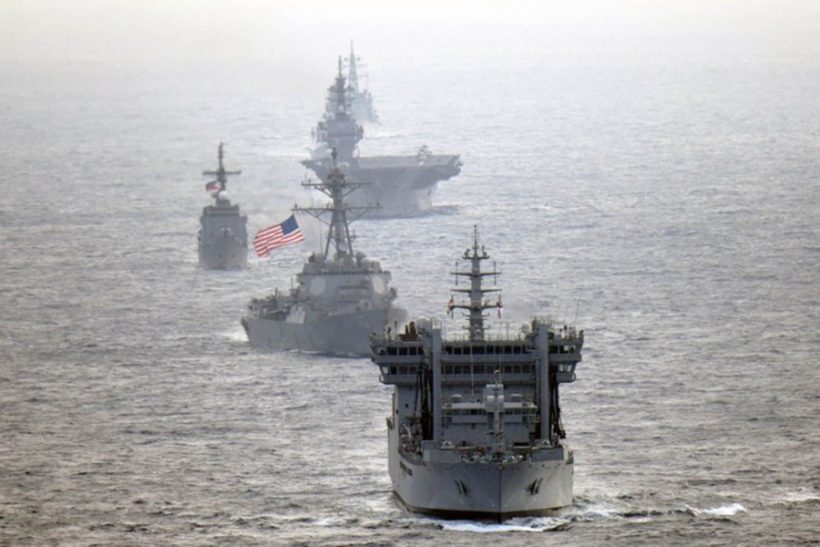U.S., Japan, India and Philippines challenge Beijing with naval drills

The U.S. on Wednesday finished a weeklong sail through the South China Sea with India, Japan and the Philippines, a region fraught with tension amid disputed territorial claims, according to a Navy statement Thursday.
The guided-missile destroyer USS William P. Lawrence joined the Indian navy destroyer INS Kolkata and tanker INS Shakti; Japan Maritime Self-Defense Force helicopter carrier JS Izumo and destroyer JS Murasame; and Philippine navy patrol ship BRP Andres Bonifacio in international waters May 2-8.
The six vessels gathered “to train together and promote maritime cooperation throughout a free and open Indo-Pacific,” the Navy said in the statement.
The ships practiced “formation exercises, communication drills, passenger transfers and held a leadership exchange aboard JS Izumo” during the exercise, according to the statement.
The region is important to trade and rich in natural resources. Five nations — China, Malaysia, the Philippines, Vietnam and Taiwan — have overlapping claims to almost 70 reefs and islands in the South China Sea, according to the Center for Strategic and International Studies Asia Maritime Transparency Initiative.
The…exercise follows a U.S. request in December that its Pacific allies boost their military presence in the South China Sea. China continues to claim and militarize reefs and islands in the region, contrary to a 2016 decision by a United Nations tribunal.
China has created 3,200 new acres of land in the sea’s Spratly Islands since 2013, building artificial land masses for military outposts, according to the center.
Last year, China placed “anti-ship cruise missiles and long-range surface-to-air missiles on outposts in the Spratly Islands,” according to a report on China’s military power published last week by the U.S. Defense Department.
In response to the report, China Foreign Ministry spokesman Geng Shuang said at a press briefing Monday that “China pursues peaceful development and a defense policy that is defensive in nature,” according to a transcript.
Randy Schriver, assistant U.S. Secretary of Defense for Asian and Pacific affairs, in an interview with The Australian newspaper in December, proposed bringing more pressure on the Chinese by having “other partners and allies joining in these activities” in the South China Sea.
“If not freedom-of-navigation operations … just joint patrols, presence operations,” he added, according to The Australian.
Freedom-of-navigation operations challenge territorial claims and are often conducted by sending ships within 12 nautical miles of a disputed land mass.
Days before the four-nation exercise began, the USS William P. Lawrence sailed the Taiwan Strait with the guided-missile destroyer USS Stethem April 28, irking China.
William P. Lawrence commanding officer Cmdr. Andrew Klug said working with Pacific allies strengthens international partnerships.
“Professional engagements with our allies, partners and friends in the region are opportunities to build upon our existing, strong relationships, as well as learn from each other,” Klug said in the Navy statement.
JMSDF Rear Adm. Hiroshi Egawa, commander of Escort Flotilla 1, said the four-country exercise “built mutual understanding and trust” and “enhance[d] peace and stability in the Indo-Pacific region,” according to the Navy statement.
“The ability to do various exercises among four different navies smoothly demonstrated professionalism and high operational skills,” Egawa said in the statement.
Image Source: https://www.studentnewsdaily.com/wp-content/uploads/2019/05/usslawrence_may2019-820x547.jpg
Article Source: https://www.studentnewsdaily.com/daily-news-article/u-s-japan-india-and-philippines-challenge-beijing-with-naval-drills/
Vocabulary:
1. dispute / verb : to engage in argument or debate.
2. overlap / verb : to cover and extend beyond (something else):
3. outpost / noun : a station established at a distance from the main body of an army to protect it from surpriseattack:
4. ally / noun : a person, group, or nation that is associated with another or others for some common cause orpurpose:
5. territorial / adjective : of or relating to territory or land.
Questions:
1. The first paragraph of a news article should answer the questions who, what, where and when. List the who, what, where and when of this news item. (NOTE: The remainder of a news article provides details on the why and/or how.)
2. What is the stated purpose for the unified sail through?
3. What did the the ships from the four countries do during the joint military venture?
4. What is the significance of the South China Sea?
5. Which countries have made claims to the reefs and islands in the South China Sea?
6. What actions by China led the U.S. to request its Pacific allies to increase their military presence in the South China Sea?
7. How do you think the other governments involved regard the U.S.’s push to make their united presence felt?